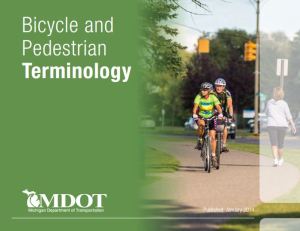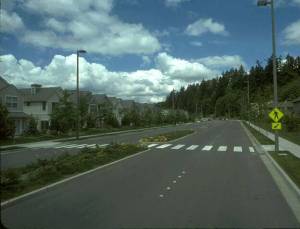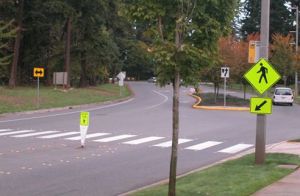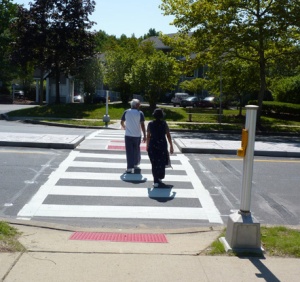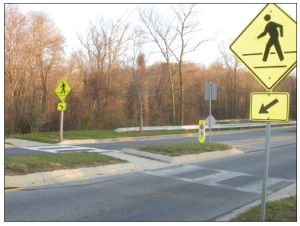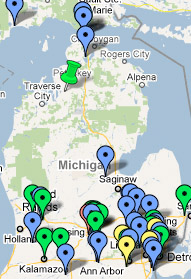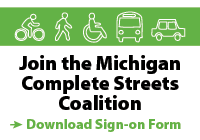You are currently browsing the tag archive for the ‘Pedestrian’ tag.
The Michigan Department of Transportation recently released a glossary of Bicycle and Pedestrian Terminology, a must-have resource for transportation advocates, citizens, and planners. Many non-motorized terms are similar, and some tend to be confused or misused. For example, could you state the difference between a bike lane, bike boulevard, and bike route? This glossary brings clarity to non-motorized discussions and when used, will help improve the conversation around pedestrian and bicycling issues.
This post continues an ongoing blog series highlighting various complete street elements, their benefits, and use in Michigan communities. Check back often to catch future posts, and keep a lookout for mid-block pedestrian crossings in your community!
What are Mid-Block Pedestrian Crossings? Mid-block pedestrian crossings are marked crosswalks placed between intersections. They look similar to intersection crosswalks, but often incorporate several design features to increase safety. Mid-block crossings frequently include pedestrian islands, which provide a safe refuge for pedestrians crossing two-way traffic. Users can check traffic one way, cross to the island, and check traffic in the other direction before continuing to cross. Yield lines can be set back to require vehicles to stop farther away from the intersection. Bulb-outs that narrow the roadway can be used to calm traffic by slowing speeds, and can make pedestrians more visible to drivers. Where traffic volumes are heavy, mid-block crossings can be signalized to further increase safety and comfort.
Why Use Mid-Block Pedestrian Crossings? Many people do not go out of their way to cross at established intersections. Instead, they choose to cross the street using the most direct route, even if that means crossing several lanes of busy traffic. Mid-block pedestrian crossings decrease random and unpredictable crossings associated with a high risk of collisions, especially in areas that are heavily travelled by pedestrians or where block lengths are long.
When to Use Mid-Block Pedestrian Crossings: An engineering study should be completed to determine the need for a mid-block crossing, which incorporates roadway width, traffic volume, traffic speed and type, desired lines for pedestrian movement and adjacent land use. Heavily traveled areas that have high incidences of random crossings are good candidates for mid-block crossings, including schools, shopping centers, transit centers, and college campuses.
The above factors also determine whether bulb-outs, pedestrian islands, and signals should be incorporated into the mid-block crossing design. In general, local roads with low speeds and low traffic volumes are less likely to need these additional elements. As speed limits, number of lanes, and traffic volumes increase, these additional traffic calming and safety elements become increasingly necessary.
Safety Benefits: Mid-block locations account for more than 70% of pedestrian fatalities. Mid-block pedestrian crossings increase safety by decreasing random and unexpected pedestrian crossings. As stated before, people tend to cross where it is most convenient for them to cross, creating a high risk of collisions. Mid-block pedestrian crossings consolidate pedestrian traffic and allow drivers to predict and expect pedestrian traffic. Around 83% of pedestrians surveyed in an East Lansing, MI study changed their crossing behaviors where mid-block crossings were present. Where pedestrian islands have been included in the crosswalk design, pedestrian crashes were reduced by 46% and vehicle crashes were reduced by 39%. Because mid-block crosswalks can be difficult to use for individuals with visual impairments, adding a crosswalk signal to the crossing will help make the treatment safer for all users.
What Drivers Should Know: While mid-block pedestrian crossings help drivers know where pedestrians are most likely to cross, some pedestrians may still choose to cross at random points along the road. Accordingly, drivers should remain alert for pedestrians crossing outside of the crosswalk. Be aware of signage that will signal a mid-block crossing is approaching. When coming up to unsignalized and signalized mid-block crossings, drivers should prepare to yield in anticipation of pedestrians crossing. Where a pedestrian is on a crosswalk or when alerted by signal, a driver must stop behind the yield lines that proceed the crosswalk.
Cost Considerations: Costs for mid-block pedestrian crossings can vary significantly with mid-block characteristics and the need for pedestrian islands, signals, or bulb-outs. Additional treatment costs include Bulb-outs, which can cost between $5,000 and $25,000 per corner, pedestrian islands, which can run between $4,000 and $30,000, and countdown/crosswalk signals, which can cost between $5,000 and $15,000. More Expensive Pedestrian Hybrid Beacons can be included if deemed necessary. Adding these elements during planned construction will help to decrease project costs.
Mid-block pedestrian crossings are common in Michigan. A few examples include: East Lansing, which has a mid-block crosswalk that covers five lanes of traffic, and includes a pedestrian shelter; a short mid-block crossing between Michigan and Allegan along Washington Street’s business district in Lansing; and a crossing outside Frost Elementary School in Jackson.
Have mid-block pedestrian crossings in your community? Let us know.
Check out these resources for more information:
Best Design Practices for Walking and Bicycling in Michigan (Pages 26, 27, 29, and 32)
Crossing Enhancements Commonly Used in Mid-block Crossings
FHWA Course of Mid-block Crossings
MDOT Presentation on Design Ideas to Improve Pedestrian and Bicycle Safety
Mid-block Fact Sheet from Kansas DOT
Next Topic: Road Diets
Previous Topic: Contra-flow Bike Lanes
This post continues an ongoing blog series highlighting various complete street elements, their benefits, and use in Michigan communities. Check back often to catch future posts, and keep a lookout for pedestrian hybrid beacons in your community!
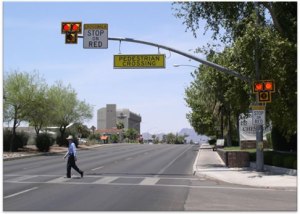 What are Pedestrian Hybrid Beacons? Also known as HAWK Signals (High Intensity Activated Crosswalk signals), pedestrian hybrid beacons are traffic devices used to assist pedestrians crossing busy streets. When a pedestrian activates the system by pressing a button, overhead flashing yellow lights alert drivers that pedestrians have activated the signal. The yellow light then turns solid, preparing drivers to make a complete stop at the intersection. When the light turns red, pedestrians receive a white “walk” signal, and may proceed across the intersection. A flashing red appears when the pedestrian countdown starts, telling the driver that if the intersection is clear, he or she may proceed through it with caution. When the pedestrian countdown has expired, the beacon goes dark and traffic continues on its way.
What are Pedestrian Hybrid Beacons? Also known as HAWK Signals (High Intensity Activated Crosswalk signals), pedestrian hybrid beacons are traffic devices used to assist pedestrians crossing busy streets. When a pedestrian activates the system by pressing a button, overhead flashing yellow lights alert drivers that pedestrians have activated the signal. The yellow light then turns solid, preparing drivers to make a complete stop at the intersection. When the light turns red, pedestrians receive a white “walk” signal, and may proceed across the intersection. A flashing red appears when the pedestrian countdown starts, telling the driver that if the intersection is clear, he or she may proceed through it with caution. When the pedestrian countdown has expired, the beacon goes dark and traffic continues on its way.
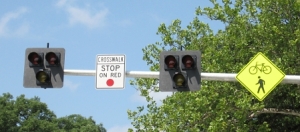 Pedestrian hybrid beacons have overhead crosswalk signs to further alert drivers to the pedestrian crossing. For the full breakdown of the sequence with pictures, see the City of Ann Arbor’s guidance. Because these signals can be confusing to new users, extensive education campaigns should run in tandem with the installation.
Pedestrian hybrid beacons have overhead crosswalk signs to further alert drivers to the pedestrian crossing. For the full breakdown of the sequence with pictures, see the City of Ann Arbor’s guidance. Because these signals can be confusing to new users, extensive education campaigns should run in tandem with the installation.
Why Use Pedestrian Hybrid Beacons? Pedestrian hybrid beacons provide pedestrians a safer crossing alternative than traditional crosswalks, especially in mid-block locations that are heavily travelled by pedestrians. Because the devices are only activated when a pedestrian is present, drivers experience minimal delays.
When to Use Pedestrian Hybrid Beacons: Pedestrian hybrid beacons became an approved traffic device in the Federal Highway Administration’s (FHWA) Manual on Uniform Traffic Control Devices (MUTCD) in 2009. The manual states that pedestrian hybrid beacons must be installed at marked crosswalks. Whether the devices are appropriate for a particular intersection primarily depends on traffic volumes and pedestrian counts (the MUTCD provides a sliding scale for high-speed roadways and low-speed roadways). Pedestrian walking speeds, posted vehicle speed limits, pedestrian delay time, and street widths are considered as well. The MUTCD recommends the following placement requirements for pedestrian hybrid beacons:
- The pedestrian hybrid beacon should be installed at least 100 feet from side streets or driveways that are controlled by STOP or YIELD signs,
- Parking and other sight obstructions should be prohibited for at least 100 feet in advance of and at least 20 feet beyond the marked crosswalk, or site accommodations should be made through curb extensions or other techniques to provide adequate sight distance,
- The installation should include suitable standard signs and pavement markings.
In practice, pedestrian hybrid beacons are often located at minor street intersections that are controlled by stop signs, opposite of the MUTCD’s guidance (A FHWA safety study consisted of 21 pedestrian hybrid beacons at minor street intersections). Transit and school locations are excellent candidates for these devices.
Safety Benefits: Data suggest that pedestrian hybrid beacons are effective safety devices for pedestrians when coupled with enforcement and education campaigns. A 2010 FHWA before-and-after study found that pedestrian hybrid beacons led to a 29% reduction in total crashes, a 69% reduction in pedestrian crashes, and a 15% reduction in severe crashes. The District of Columbia Department of Transportation found an average pedestrian hybrid beacon compliance rate of 97.1%, showing that drivers are much more likely to stop for pedestrians wishing to cross the street at crosswalks equipped with the devices. Where pedestrian hybrid beacons are placed at mid-block locations, safety gains are particularly notable: up to 70% of pedestrian fatalities occur at mid-block locations, where drivers travel at higher speeds and are less likely to be cognizant of pedestrians. Michigan communities considering installing a pedestrian hybrid beacons should note that education and enforcement efforts at the time of the installation play a key role in safety gains.
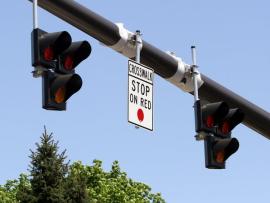 What Drivers Should Know: Pedestrian hybrid beacons are only activated when pedestrians wishing to cross a street activates the signal. If the lights of the beacon are dark, vehicles can proceed through the crosswalk. Flashing yellow lights usually last around three seconds, during which the driver should prepare to stop. A solid yellow light indicates the driver must stop. Once the light turns red, pedestrians will cross. Flashing red lights indicate that if there are no pedestrians in the walk, the driver may proceed through the walk with caution. After the flashing red lights, the signal will go dark again, and vehicles may freely pass through the intersection again.
What Drivers Should Know: Pedestrian hybrid beacons are only activated when pedestrians wishing to cross a street activates the signal. If the lights of the beacon are dark, vehicles can proceed through the crosswalk. Flashing yellow lights usually last around three seconds, during which the driver should prepare to stop. A solid yellow light indicates the driver must stop. Once the light turns red, pedestrians will cross. Flashing red lights indicate that if there are no pedestrians in the walk, the driver may proceed through the walk with caution. After the flashing red lights, the signal will go dark again, and vehicles may freely pass through the intersection again.
Cost Considerations: Pedestrian hybrid beacons are more expensive than traditional crosswalks, but remain an attractive option due to safety benefits. The average beacon costs from around $75,000 to $150,000, with signals suspended by span wire being less expensive, and signals attached to a mast arm being more expensive. Costs also vary depending on the characteristics of the particular location, road speeds, engineering constraints, and other factors.
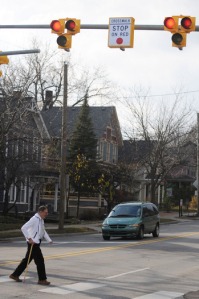 Pedestrian hybrid beacons are showing up in Michigan as more communities become aware of the technology and safety benefits are realized. The Michigan Department of Transportation (MDOT) installed the first pedestrian hybrid beacon on a state trunkline in 2010 in downtown Ann Arbor. MDOT has since installed a pedestrian hybrid beacon on US 12 BR (Michigan Ave) in Ypsilanti, and The City of Ypsilanti recently set forth plans to construct one on Michigan Avenue along the Border-To-Border Trail. Wayne State University has also installed a pedestrian hybrid beacon along Anthony Wayne Drive to help make pedestrian travel safer.
Pedestrian hybrid beacons are showing up in Michigan as more communities become aware of the technology and safety benefits are realized. The Michigan Department of Transportation (MDOT) installed the first pedestrian hybrid beacon on a state trunkline in 2010 in downtown Ann Arbor. MDOT has since installed a pedestrian hybrid beacon on US 12 BR (Michigan Ave) in Ypsilanti, and The City of Ypsilanti recently set forth plans to construct one on Michigan Avenue along the Border-To-Border Trail. Wayne State University has also installed a pedestrian hybrid beacon along Anthony Wayne Drive to help make pedestrian travel safer.
Have a pedestrian hybrid beacon in your community? Let us know.
UPDATE:
We were recently notified by the City of Dearborn that it has installed a HAWK signal on Evergreen Road, which connects the University of Michigan-Dearborn’s main campus to the new student housing development (across Evergreen). The signal was completed in August 2013 with plans to extend the non-motorized trail through the Fairlane Town Center roads. The signal was a critical piece for the connection which extends the existing Rouge River Gateway Trail (21+ mile trail) into Dearborn’s urban city fabric.
Check out these resources for more information:
Driver View and Pedestrian View of Pedestrian hybrid Beacon Operations
FHWA Proven Safety Measures: Pedestrian Hybrid Beacon
Next Topic: Contra-Flow Bike Lanes Explained
Previous Topic: Sharrows Explained
From the National Center for Bicycling and Walking:
NEW VERSION OF ONLINE PED SAFETY GUIDE RELEASED
-> According to the Nov. 12th UNC HSRC Directions newsletter, “The Federal Highway Administration (FHWA), through a contract with HSRC’s Pedestrian and Bicycle Information Center (PBIC), recently released a 2013 version of the Pedestrian Safety Guide and Countermeasure Selection System (PEDSAFE), an online guide for implementing countermeasures to improve the safety and mobility of pedestrians. The information and tools available in PEDSAFE 2013 (http://bit.ly/1fUlPIp), enables practitioners to effectively select and review primarily engineering and roadway infrastructure improvements to improve the safety of the walking environment.
“‘The safety and mobility of pedestrians needs to be considered when designing new construction or renovating existing roadways,’ said Charlie Zegeer, one of the main PEDSAFE contributors and director of the PBIC. ‘PEDSAFE helps practitioners learn from the latest safety research, updated guidelines and best practices, to identify treatments that might work in their local communities, all with the ultimate goal of helping reduce pedestrian deaths and injuries.’ PEDSAFE is comprised of four sections: a guide of basic information, specific countermeasure details, case studies (success stories) and an expert system tool for countermeasure selection, as well as links to dozens of other helpful web resources…”
Source: http://bit.ly/1h25011
Title & Author: “PBIC updates PEDSAFE Guide and Countermeasure Selection System” by Staff
REVAMPED YOUTH PED EDUCATION & SAFETY RESOURCES
-> According to the Nov. 12th UNC HSRC Directions newsletter, “Everyone needs physical activity and options for getting around in their community, and learning basic pedestrian safety can help prevent injuries and prepare youth for a lifetime of safe walking. FHWA’s Pedestrian Safer Journey, newly revamped by HSRC, provides resources to help educators, parents and others who care about pedestrian safety get the conversation started. The new Pedestrian Safer Journey tools are tailored to three specific age groups: 5-9, 10-14, and 15-18…
“The free resources available at http://bit.ly/12HNCpv consist of videos (in both English and Spanish), quizzes, discussions and an educator’s resource library that can be used as an introduction to pedestrian safety skills or to augment a comprehensive curriculum. The program can be used in a classroom or one-on-one. It addresses topics such as picking the safest places to walk and to cross streets, and the importance of being alert.”
Source: http://bit.ly/1bCluFI
Title & Author: “Pedestrian Safer Journey prepares youth for a lifetime of safe walking” by Staff
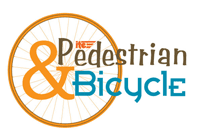
Click graphic to learn more about the Institute of Transportation Engineers Pedestrian & Bicycle Council
At the 2009 ITE Annual Meeting in San Antonio, the last panel of the last day focused on pedestrian safety, with a presentation by Meghan Mitman on recent crosswalk research and another by me on potential changes to the vehicle code, driver’s manual and Manual on Uniform Traffic Control Devices (MUTCD) to improve driver and pedestrian comprehension of crosswalk right of way.
Research performed by Meghan with David Ragland and Charlie Zegeer in the early part of the 2000s revealed a very troubling phenomenon related to a basic understanding of who has the legal right of way at uncontrolled crosswalks. Their research focused on California, where the California Vehicle Code requires that drivers yield to pedestrians at crosswalks and defines crosswalks as an extension of a sidewalk across an intersection, regardless of whether it is marked. Their research shows that the more complex the intersection, the less comprehension there is among drivers and pedestrians about who has the legal right of way: At intersections where all legs are marked, comprehension was greatest; and at intersections where no crosswalks are marked, comprehension is the worst with nearly half of drivers not understanding that they are legally required to yield the right of way to pedestrians. Read the rest of this entry »

